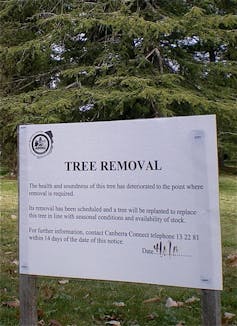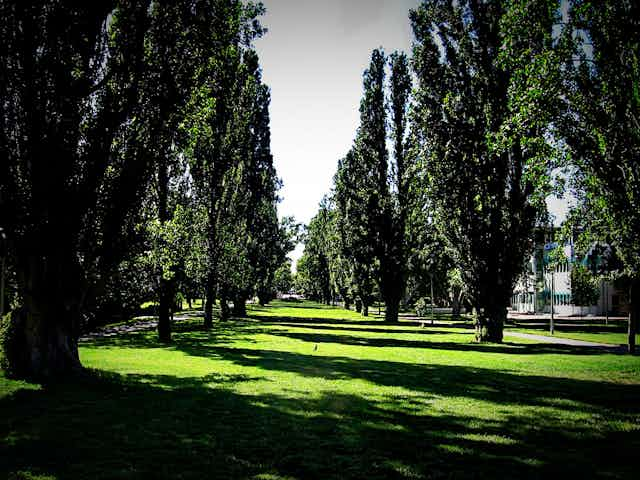Planting more trees in our cities is a no-brainer, isn’t it? The federal government certainly thinks so, having last month unveiled a plan to increase the amount of tree cover in Australia’s cities.
Tall trees with luxuriant canopies provide a wide range of benefits to sweltering urbanites. They reduce the urban heat island effect, take up carbon dioxide from the air, reduce wind, muffle traffic noise, help to retain rainwater, attract wildlife, improve human health, and they look nice.
To take an example, Canberra’s 400,000 trees – all planted in the past century or so – now deliver benefits worth up to A$15 million per year.
But trees are living things and start their urban life as small plants. It may take 50 years or more to reach their mature size and full value. So to get quick benefits, trees are “over-planted”, with many small tree canopies adding together for a significant overall effect.
But this eventually leads to competition between the trees, which reduces their value, and so trees are then periodically thinned out. Such thinning is often not appreciated. The pioneering urban forester Charles Weston, tasked with turning Canberra’s barren landscape into a site fit for the nation’s newly chosen capital, over-planted for quick effect. His successor Lindsay Pryor then thinned out the trees, to help maintain the benefits, for which he was widely criticised:
Large sums of money are spent in planting trees and large sums in rooting the majority of them out - Minister for the Interior Harry Foll, 1940
…wanton destruction … unless the citizens of Canberra rise in their wrath, Canberra will soon look [like a barren and cold plain] as it did – Letter, Canberra Times, 1946
Then of course, there’s the climate
In the half-century or more needed for urban trees to grow to mature size, things change. Over the past 50 years, for example, climates have changed, generally becoming harsher for trees that are already in relatively inhospitable city environments featuring sealed surfaces. So if we plant trees now, we need choose species that will thrive in the expected conditions of 2050 and beyond.
Infrastructure also changes during the intervening decades. Within the lifespan of some city trees, trams came and went in Sydney, while light rail is poised to bounce back in many cities, Canberra included.
Roads, power lines, telecommunications cables are built, renovated or ripped up. With each change, the land on which the trees grow becomes more or less valuable, and so do the benefits provided by the trees. Even good city planning can lead to problems – land reserved for future development is planted with trees until the development is ready to be built, but then the developers are accused of “wanton destruction”.
Trees are now competing for space and resources in new ways. Fifty years ago, no one dreamed that roof-mounted solar panels would be so important, and that large, shady trees would thus compete with green energy. Now, new suburbs are advertising their green credentials with their mandated solar panels that are not obstructed by tall trees. Shrubs and short trees may adorn these new suburbs, but they don’t replicate the benefits of large trees. Who knows what trees might get in the way of in the future?
Even more challenging is the fact that trees are mortal. True, they can live for many decades or even centuries (although most do not). Even when trees live for over a century in a city, it might not be safe to walk or park your car beneath them. Many mature trees, especially gumtrees, naturally carry dead branches high in their mature crowns – and it doesn’t take too many half-tonne branches falling from 20 m to give trees a bad reputation. Public responses to death or severe injury from falling branches often include demands to remove all trees that cannot be guaranteed as safe, despite this guarantee being impossible.

Urban foresters often rate trees by their useful life expectancy (ULE). Trees reach their maximum ULE when the cost of maintenance and risk of injury exceeds their value. But even using this objective measure, politicians and the public still often protest against cutting down mature trees that they personally don’t consider dangerous.
If lots of trees are planted at the same time, say as part of a government initiative or suburban development, it is likely that they will all reach their maximum ULE together. What’s more, factors such as drought could trigger all trees planted in the same year in a particular area to hit their maximum ULE all at the same time.
Removing lots of trees all at once may be necessary, but will also be expensive, exacerbate the urban heat island effect, and lead to public backlash. Staggering removals and replanting, even before maximum ULE, will encourage a better mix of tree ages, development states and healthy diversity. Regular removal of large trees close to the end of their useful lives could also supply valuable raw material to sustainable cottage industries such as flooring, panelling and furniture from urban wood.
To beat the urban heat island effect we need to ensure that we pay for planning as well as planting. This means proper species selection and future maintenance of tall, mature trees. We need to educate then maintain the political and public knowledge over 50 years of why the trees were planted, why they need to be thinned out, and why they need to be systematically cut down and replaced.

